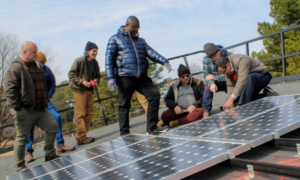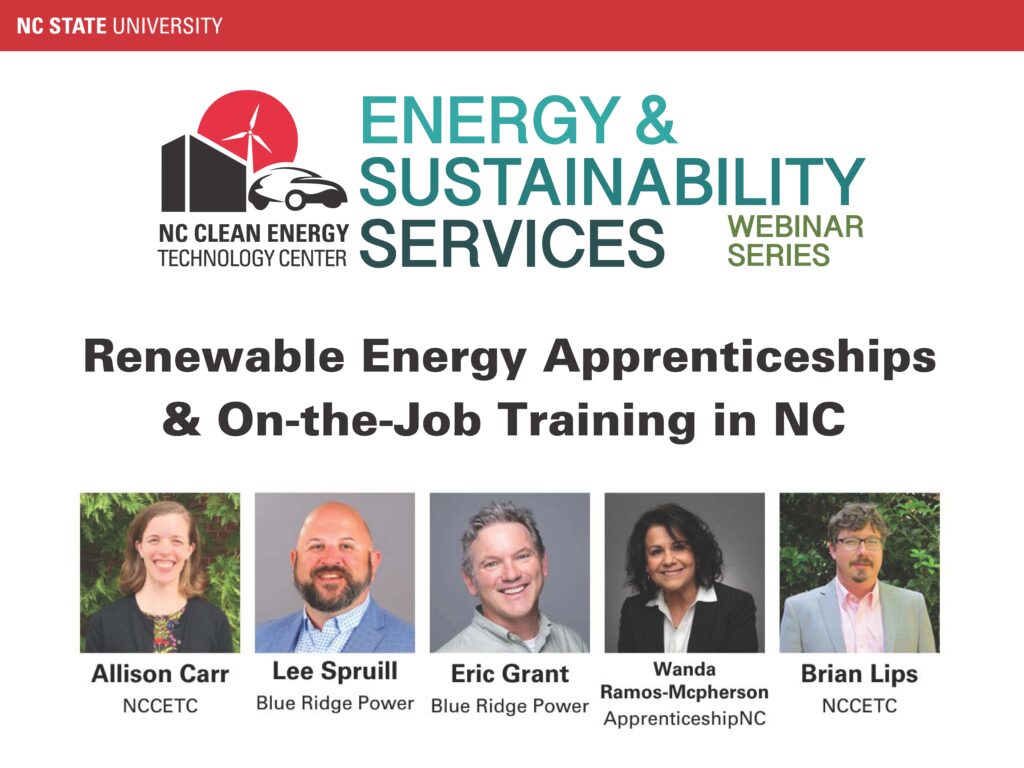Renewable Energy Apprenticeships and On-the-Job Training in North Carolina
 For 35 years, the North Carolina Clean Energy Technology Center (NCCETC) at NC State University has supported the growth of the clean energy industry by providing training and supporting the expansion of a skilled workforce. The rapid changes in the industry requires coordination to help employees develop skills needed for hiring into jobs. Apprenticeships and on-the-job training opportunities allow employees to “earn while they learn” and help employers hire for immediate needs.
For 35 years, the North Carolina Clean Energy Technology Center (NCCETC) at NC State University has supported the growth of the clean energy industry by providing training and supporting the expansion of a skilled workforce. The rapid changes in the industry requires coordination to help employees develop skills needed for hiring into jobs. Apprenticeships and on-the-job training opportunities allow employees to “earn while they learn” and help employers hire for immediate needs.
NCCETC is proud to support the expansion of clean energy education and training as a part of the STEPs4GROWTH project. The primary goal of the STEPs4GROWTH project is to connect clean energy industry partners with qualified apprenticeship candidates and provide opportunities for recent high school graduates, community college students, and four-year college students to gain hands-on experience.
STEPs4GROWTH is a four-year, $23.7 million project funded by the Department of Commerce’s Economic Development Administration (EDA) Good Jobs Challenge and led by the Center for Energy Research & Technology at North Carolina Agricultural and Technical State University (NC A&T). This project aligns with NCCETC’s mission as a public service center seeking to advance a sustainable energy economy by educating, demonstrating, and providing support for clean energy technologies, practices and policies.
 Earlier this month, NCCETC hosted Renewable Energy Apprenticeships & On-the-Job Training in North Carolina, a free webinar offered as part of its Energy & Sustainability Services Webinar Series. NCCETC’s Training Program Manager Allison Carr moderated the panel discussion which featured Brian Lips of NCCETC, Eric Grant and Lee Spruill of Blue Ridge Power, and Wanda Ramos-McPherson of ApprenticeshipNC. The full webinar recording is now available to stream online. The presentation slides are also available to view and download.
Earlier this month, NCCETC hosted Renewable Energy Apprenticeships & On-the-Job Training in North Carolina, a free webinar offered as part of its Energy & Sustainability Services Webinar Series. NCCETC’s Training Program Manager Allison Carr moderated the panel discussion which featured Brian Lips of NCCETC, Eric Grant and Lee Spruill of Blue Ridge Power, and Wanda Ramos-McPherson of ApprenticeshipNC. The full webinar recording is now available to stream online. The presentation slides are also available to view and download.
The Inflation Reduction Act
The webinar began with an overview of the Inflation Reduction Act (IRA) and other relevant policies pertaining to apprenticeship in North Carolina. Brian Lips serves as Manager of the Database of State Incentives for Renewables and Efficiency (DSIRE) project, a publicly available resource on federal, state and utility policies and incentives for renewable energy, efficiency, energy storage, and electric vehicles.
“The IRA is the single largest investment in clean energy by the federal government,” Lips said. “It extended many historic tax credits that had previously required annual or semi-annual reauthorization by Congress, and created some new tax incentives for clean energy technologies. It also modified the historic tax credits by establishing new bonus credits for projects that meet certain criteria.”
PREVAILING WAGE REQUIREMENTS
The IRA amended the Internal Revenue Code to add prevailing wage and Registered Apprenticeship requirements for taxpayers constructing, and in some case, performing alterations or repairs of qualified clean energy facilities, property, projects, or equipment to qualify for increased tax credit or deduction amounts. By pairing climate investment with the creation of good paying jobs, the IRA’s unparalleled investments to mitigate the effects of climate change will help improve job quality in clean energy industries and incentivize the expansion of workforce training pathways into these jobs.
As Lips explained, federal tax credits have always been an important driver for expanding the solar industry. Previous versions of relevant tax credits coupled with the competitive nature of the electric utility industry led renewable energy developers to seek the lowest possible prices for materials and labor. “With the solar industry in a more mature state, the federal government is now using these tax credits to encourage the solar industry to use materials that are made in America and labor that is paid good wages,” said Lips.
The Department of Labor explains on its website that, in general, taxpayers wishing to take advantage of enhanced clean energy tax benefits must ensure that all laborers and mechanics are paid the applicable Davis-Bacon Act prevailing wage, including fringe benefits, for all hours performing work on the site of a qualified facility. Furthermore, “A prevailing wage is the combination of the basic hourly wage rate and any fringe benefits rate, paid to workers in a specific classification of laborer or mechanic in the area where construction, alteration, or repair is performed, as determined by the Secretary of Labor.”
REGISTERED APPRENTICESHIP REQUIREMENTS
The inclusion of Registered Apprenticeship provisions also enables a talent pipeline for developing this critical workforce and ensures that it is an industry-driven approach with high-quality career pathway opportunities for all workers. By utilizing Registered Apprenticeships, employers can develop and prepare their future workforce, and individuals can obtain paid work experience, receive progressive wage increases, classroom instruction, and a portable, nationally-recognized credential.
“In 2023, 12.5% of the total labor hours for a project must be completed by what they call qualified apprentices and then, for all future years, it increases to 15%,” noted Lips. A qualified apprentice under the IRA is an individual employed by the taxpayer, contractor or subcontractor who is participating in a Registered Apprenticeship program registered under the National Apprenticeship Act.
Wanda Ramos-McPherson, an Apprenticeship Consultant for ApprenticeshipNC, described a Registered Apprenticeship as a training program that consists of work-based learning designed to meet the training needs of the employer by providing the employee with structured on-the-job learning, related instructure, and a progressive wage scale.
“An apprenticeship program is an opportunity for employers to develop a talent pipeline for a skilled workforce,” said Ramos-McPherson. “It is a collaborative partnership where we all work together to meet the needs of the employer as far as training and hiring out their workforce.”
Apprentices can acquire several benefits and skills by participating in an apprenticeship, according to Ramos-McPherson. “Apprenticeships provide long-term paid work experience combined with structured educational curriculum that ensures they gain the education and hands-on work experience required for the occupation,” she explained. Apprentices are able to earn a wage while learning on-the-job skills and they may also qualify for funding opportunities such as community college tuition waiver benefits.
Ramos-McPherson also identified the benefits to the employer for participating in, and hiring from, the apprenticeship program. She said, “As employers face the challenges of a tight labor market, finding and retaining employees, an apprenticeship program can support employers by helping to develop a highly skilled workforce that will help to improve productivity, profitability, and an employer’s bottom line.”
For employers, apprenticeship programs facilitate flexible training options that guarantee workers develop the right skills while minimizing liability costs through appropriate training by providing a mentor or subject matter expert to train apprentices. Employers may also receive tax credits and employee tuition benefits in North Carolina as well as funding opportunities, if they qualify, through ApprenticeshipNC, the Workforce Boards, and other funding streams.
Active On-the-Job Training in NC: Blue Ridge Power’s PowerUp & Workforce Development Efforts
 Eric Grant and Lee Spruill from Blue Ridge Power discussed the company’s on-the-job training program – PowerUp – that builds competency during job placement. Grant, Director of Learning and Development for Blue Ridge Power, led the development of Blue Ridge’s PowerUp Apprenticeship Program and challenge-based workforce development curriculum.
Eric Grant and Lee Spruill from Blue Ridge Power discussed the company’s on-the-job training program – PowerUp – that builds competency during job placement. Grant, Director of Learning and Development for Blue Ridge Power, led the development of Blue Ridge’s PowerUp Apprenticeship Program and challenge-based workforce development curriculum.
“The solar industry will be hiring over one million employees in the next 10 years,” said Grant. “We are hiring people to do jobs they have never done before in an industry that is constantly evolving.” To meet growing demand, employers are leveraging community colleges and universities to find potential employees.
Grant explained that PowerUp was developed partially to support the need for related instruction and formalized on-the-job training required by apprenticeship guidelines. He cited high turnover rates as a second factor in developing PowerUp. “After evaluating our workforce onboarding and training at the time, we recognized a gap – all of the training was in the field and many new hires did not know the names of tools they were using, how to use them, or how the parts went together,” Grant said.
PowerUp provides an initial launch for apprenticeship related instruction hours and gives newly hired employees basic skills such that they arrive on site with more competence and confidence. “As a result, we were able to cut the turnover rate by more than 50% last year,” added Grant.
PowerUp provides 40 hours of training focused on safety, tool skills, company core policies and values, construction knowledge and other skills. “The format is fairly simple, we provide the safety and construction knowledge and skills in the morning, then place the participants in teams to perform the task in the afternoon,” said Grant. By placing the participants in teams, the training is game-ified and teams earn or lose safety and quality points based on how effectively they perform the task. The teams rotate each day and, as the week progresses, a posted leaderboard helps identify emerging high performers and leaders.
Lee Spruill, Workforce Development Program Manager at Blue Ridge Power, has worked with stakeholders in multiple states to help set up registered apprenticeships. He also implemented a college and high school internship program for Blue Ridge Power. In the last year, he has been essential in leading the effort of establishing the second solar installer pre-apprenticeship in the nation within the public school and community college setting.
“Blue Ridge Power is empowering employees by giving them the skills, knowledge and safety awareness they need to make them successful in the field prior to beginning their on-the-job training,” Spruill said. The company also provides follow-up training and support for employees once they being their work.
Blue Ridge Power uses a variety of resources to acquire skilled talent. “We have partnered with a number of local, regional, state, and national organizations for skilled talent,” noted Spruill. These include local school districts and community colleges for internships and pre-apprenticeship programs, colleges and universities, state apprenticeship agencies, military job fairs, industry partners, and a national apprenticeship consultant.
STEPs4GROWTH: Creating the Next Generation of Clean Energy Talent
The EDA Good Jobs Challenge grant award will create STEPs4GROWTH, or Successful Transitions and Effective Partnerships for Growing Regional Opportunities in the Workforce to Harness, a clean energy workforce training program that will support students, from high school and beyond, t create the next generation of clean energy talent.
“In our role as the renewable energy backbone for the STEPs4GROWTH project, we are engaging with employers and educational institutions that represent solar, wind and bio-energy sectors to bring these partners together,” said Allison Carr, Training Manager at NCCETC.
 Another major component for NCCETC’s role in the project will be to develop educational models and career pathways by working with employers to identify training needs and gaps for the growing workforce. “We are working with Blue Ridge Power and ApprenticeshipNC to identify the different credentials and skills that are needed and the courses that correlate with those to be able to create a model which industry partners, trainees, and students can use to ensure we’re building a skilled workforce,” Carr stated.
Another major component for NCCETC’s role in the project will be to develop educational models and career pathways by working with employers to identify training needs and gaps for the growing workforce. “We are working with Blue Ridge Power and ApprenticeshipNC to identify the different credentials and skills that are needed and the courses that correlate with those to be able to create a model which industry partners, trainees, and students can use to ensure we’re building a skilled workforce,” Carr stated.
There are many ways for industry partners to get involved and meet the project needs from solar companies and employers. “We want to encourage a willingness to hire STEPs4GROWTH graduates as they complete training so we can make sure these trainees are placed into good paying jobs,” said Carr.
NCCETC is currently seeking industry partners to participate in committing to hire for one or more full-time or part-time jobs, with opportunities for summer placements into apprenticeships or jobs. There is also anticipated need for job placements in Fall 2023 and beyond through the four year project. Industry partners also have an opportunity to help craft the curriculum for solar and clean energy technology across North Carolina through the educational model NCCETC is developing. NCCETC is gathering feedback on current opportunities and skills gaps in solar, wind, and bioenergy sectors.
Resources & More Information
News on the latest developments pertaining to the IRA can be found on the Internal Revenue Service website.
The national Apprenticeship program’s website is the one-stop source to connect career seekers, employers, and education partners with apprenticeship resources. They also have a webpage which provides resources on apprenticeship for background information pertaining to the IRA.
Learn more about prevailing wages and the IRA from the U.S. Department of Labor.
ApprenticeshipNC is a State Apprenticeship Agency recognized by the U.S. Department of Labor to develop and approve apprenticeship programs.
Participate in STEPs4GROWTH job placement and educational or training activities by contacting the NC Clean Energy Technology Center. Reach out via email to Allison Carr at akcarr@ncsu.edu and Samantha Gibson at sgibson3@ncsu.edu.
If you are an employer or industry partner seeking to hire STEPs4GROWTH trainees or want to learn more about job placement requirements, please complete the STEPs4GROWTH Employer Commitment Form.